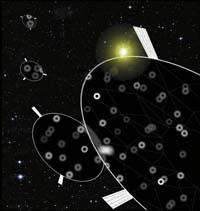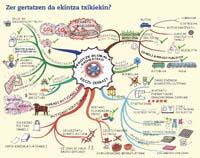Geoengineering and Geoengineering

The starting point of Geoengineering is the realization of a series of projects of great impact to reduce the temperature of the terrestrial surface. In this field, researchers propose projects ranging from ocean fertilization to the placement of panels that block solar rays in space.
The temperature of the Earth's surface depends on the balance between incoming solar radiation and the expulsion of the Earth, and human activity causes an imbalance between both radiations.
To try to correct this imbalance, from the field of geoengineering, they propose two types of solutions: Reduce solar radiation absorbed by Earth and increase the radiation emitted by Earth. In order to reduce the solar radiation the planet receives, to prevent the sun's rays from penetrating the atmosphere and not passing through the high layers of the atmosphere, alternatives have been proposed, such as the placement of panels that reflect the sun's rays in space or the emission of sulfate aerosols in the stratosphere to prevent the sun's rays from coming down -- as a result of volcanic eruptions naturally.
On the other hand, another solution is to increase the albedo of surfaces to reflect the radiation that can descend in the atmosphere. The albedo is the proportion between the radiation that absorbs and emits a surface. Several projects propose to increase the albedo of deserts and human settlements or to build structures that produce mists from the water of the sea, so that the clouds reflect the solar rays.
Among the possibilities of increasing the radiation expelling the Earth, the basic idea would be to remove excess CO 2 in the atmosphere and not reappear. For this purpose, it is proposed to increase the planet's own carbon deposits or to create artificial deposits both on land and sea.
Carbon storage

Researchers propose that the storage of CO 2 in the soil be carried out through trees and forest lands. This storage is carried out naturally, both in trees and on land. Therefore, tree planting can contribute to the absorption and collection of atmospheric CO 2. Currently, the IPCC is studying the use of tree planting as a mitigation measure. Geoengineering, on the other hand, proposes artificial structures that, imitating nature, carry out this same process, as are artificial trees that suck air and store CO 2 underground.
Similarly, bioincineration with pyrolysis, in which much of the combustion is carried out without oxygen, converts 50% of the carbon into long-life biomass, as the carbon that can be added to the soil. And the rest of the carbon that is generated can be stored and stored. At the same time, direct carbon storage systems associated with bioenergy and carbon emission generation activities, called BECS --Bio-energy with carbon storage-- have been designed. Thus, scientists investigate underground carbon storage techniques and other heating gases.
Another option is the storage of CO 2 at sea, both naturally and artificially. Naturally, both water and coastal sediments store carbon. But there are also geoengineering projects that take advantage of natural dynamics. One of them is the project proposed by the oceanic fertilizer with iron. This would increase the number of phytoplankton and phytoplankton would absorb CO 2. When the phytoplankton dies, it sinks and becomes a deposit of CO 2. This project was launched this year but unfortunately it did not go well. By increasing both the number of phytoplankton, the number of zooplankton approached the fertilized areas and ate most of the phytoplankton. Thus, instead of storing the CO 2 collected by phytoplankton on the seabed, it returned to the atmosphere through the respiration of the zooplankton. However, researchers consider that another cause of the disappearance of phytoplankton may be water acidity, a matter that is now being studied. However, in some way, the expected results have not been obtained regarding the absorption of CO 2.
However, it is not the only project of the oceans. The addition of carbonates instead of iron would increase the alkalinity of the oceans, which would mean a higher absorption of CO 2.
On the other hand, it is also possible to use carbon flows throughout the year, taking advantage of natural flows or mechanically increasing flows. If surface water were to sink, for example, adding ice in the sea to cool surface water, carbon would also sink, thus accelerating access to sediments that store carbon. In addition, it would achieve a greater and faster absorption of carbon by surface water. On the other hand, if the water of the seabed was pushed to the surface, the same would be achieved.
Effectiveness of the proposals

Tim Lenton (School of Environmental Sciences, University of East Anglia, United Kingdom) and Naomi Vaughan (Tyndall Climate Change Research Center, United Kingdom), after the analysis and comparison of their proposals in the field of geoengineering, have analysed the impact of projects. The basic criterion used for the evaluation of this type of projects is its ability to cool the climate.
The study concludes that the discharge of aerosols in the stratosphere and the placement of solar panels in space are the only ones that in 2050 are able to return to the pre-industrial situation. On the other hand, the harsh mitigation measures, combined with the absorption and storage of air on a global scale, would reduce the level of CO 2 to a pre-industrialization situation by the year 2100.
Another option would be to keep CO 2 stable through severe mitigation measures and to increase geoengineering albedo. This would not be a complete solution, but it would be possible to reduce the levels of solar radiation.
Lenton and Vaughan believe that the sinking and outcropping of ocean water would have very little influence over a significant period of time. They believed that ocean fertilization served in the long term, but experience has shown that problems arise.






